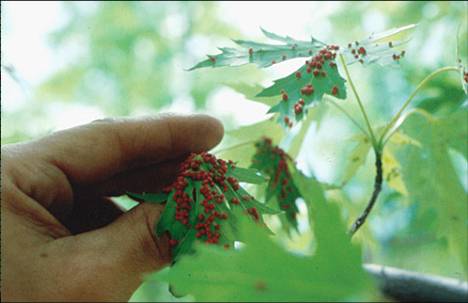

Maple Bladder Gall


| Maple
Bladder Gall Vasates quadripedes �(Riley) (232) |
|
| Order
and Family:�� Acari: Eriophyidae |
|
| Host
plants:�� Silver and red maples |
|
| Damage
and Diagnosis:� Small, wart-like
growths on the foliage are red in spring, then turn green and finally black
in summer (fig. 26).� They occur singly
or in clusters and may be so abundant that the leaves become crinkled,
deformed and drop early. These galls never cause permanent injury and
actually have little effect on tree health and vigor. They do, however,
detract from the normal beauty of the foliage. |
|
| Biology:� Maple bladder gall mites overwinter in
cracks and crevices of the bark as inactive adults.� As the buds swell in the early spring, they
migrate out to the bud scales. When the buds open, mite feeding causes the
newly developing leaves to form galls.�
Mites live, feed, and mate inside galls all summer.� In the fall, mites move back to the bark
before leaves drop. |
|
| Control:� �Since this gall maker spends the winter as
an adult on the tree, keeping some keeping old galls around will not
contribute to future gall problems and may conserve natural enemies. |